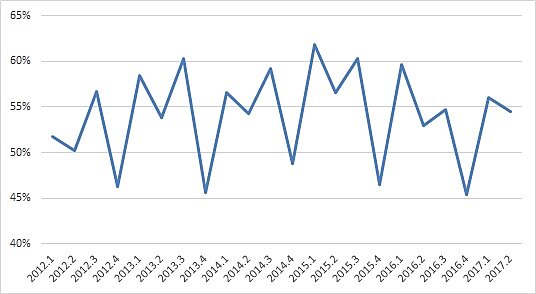E‑Verify is a federal government program that allows businesses to check the identities of new hires against federal databases to judge whether they are eligible to legally work in the United States. The goal of the program is to deny illegal immigrants work in the United States. E‑Verify has serious problems as it misidentifies a small portion of legal workers as illegal immigrants, imposes a serious regulatory burden on employers and employees, increases employee turnover costs, is expensive, stimulates black market document forging and identity theft, might increase crime, and fails in its primary function of turning off the wage magnet.
Despite all of those problems, the best thing about E‑Verify is that many employers do not use it in states where it is mandated and workers have many ways to get around the system, reducing the cost of the mandate. Government data on the number of E‑Verify checks that run in each state are sketchy and seem to change with each new FOIA but the most recent one I received from the Department of Homeland Security revealed that my previous work likely overestimated the rates of E‑Verify compliance in South Carolina.
South Carolina mandated E‑Verify for all employers in 2011 but delayed the start date until January 1, 2012, because (surprise) the system was more complicated than its proponents claimed and the state government did not want to punish every small employer in the state for noncompliance. Despite that, proponents of mandatory E‑Verify point to South Carolina as a model system because the state Department of Labor, Licensing, and Regulation (DLLR) conducts random audits of employers to guarantee that they use the system for all new hires.
Figure 1
South Carolina E‑Verify Compliance
Sources: Department of Homeland Security and Longitudinal Employer-Household Dynamics Survey.
South Carolina is the only state that audits employers and punishes them with extra regulatory burdens if they fail to E‑Verify all of their new employees but it hasn’t resulted in more compliance. South Carolina’s E‑Verify mandate has probably not reduced the state’s already low illegal immigrant population and failed to dim the wage and employment magnet that attracted illegal immigrants in the first place. In exchange, the mandate imposed greater regulatory costs on employers and made the state government appear to be a harsh enforcer of immigration laws. That is a bad tradeoff for South Carolina.
If the federal government ever mandates E‑Verify, it should follow South Carolina’s example of looking tough but ignoring inconsistencies in the system that point to its ineffectiveness. Regarding E‑Verify, the best action for South Carolina and the United States is to drop the charade by canceling the program so Americans can continue to benefit from employing illegal immigrants without E‑Verify’s extra regulatory burdens that only help a few South Carolina politicians look tough.
Note: The author made some updates to the statistics and graphs in this post on April 26, 2018 as the result of further federal government data.

